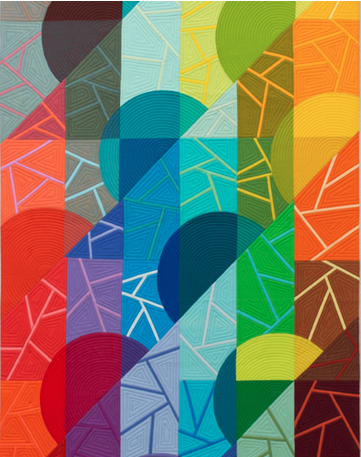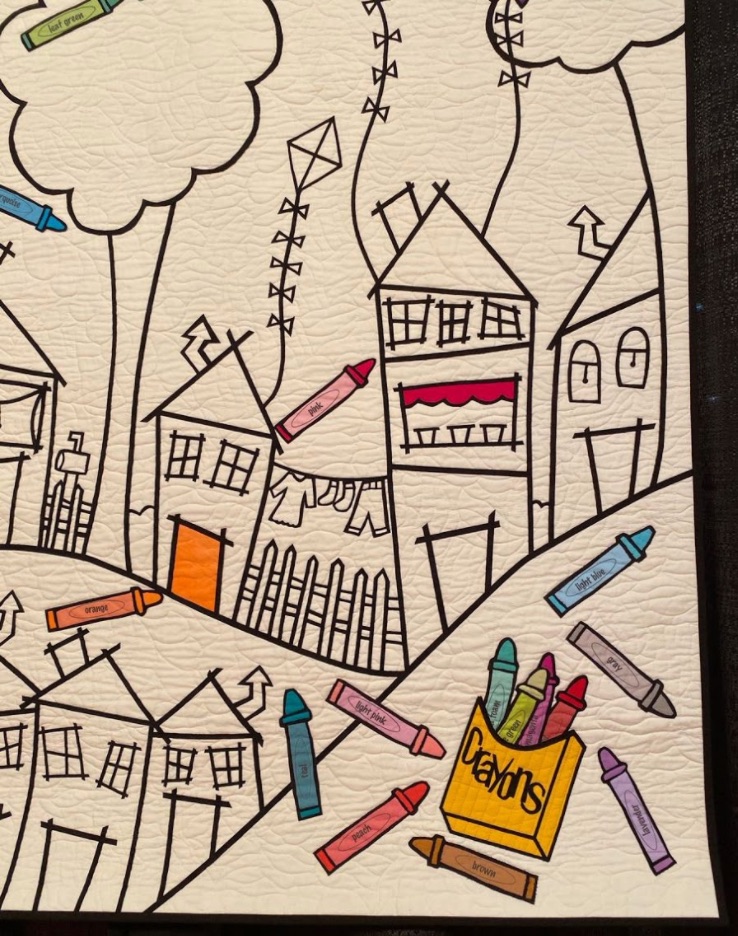 4
4

In our last lesson in The Art of Quilt Design program, we focused on Unity (Lesson 40). Unity can be thought of as everyone in a group working together. Unity represents calmness and order through repetition, either by shape or color. It can be achieved with pattern, color, or theme. But, unity can also become somewhat boring if the elements, while being the same, are not different enough in some way. That is where variety helps to shake things up a bit for the viewer. Variety adds that bit of spice to a quilt without sacrificing the idea of the group working together as a whole.

An easy way to remember is... Unity adds harmony; Variety adds interest.
In this example, notice how all of the droplets on the left are the same color, but different sizes. In the area on the right all of the droplets are a different color, but the same size.

Not sure where to start? How about selecting a simple block to see how far it's possible to push the variety. The traditional clamshell block offers many options for creativity interpretation.

Treat each clam as an individual unit. A bit of edging or trim along the top edge to add more interest.
Happy As A Clam by Rachael Daisy. (Image courtesy of Rachael Daisy)
Arrange individual clam units in different directions to create movement across the quilt. Or, build pieced units to create a sampler look.


Clam Toss by Latifah Saafir. (Show 2502) [Image TheQuiltShow.com]. Callou by Latifah Saafir (Image TheQuiltShow.com)


Make each and every clamshell unique. You get the idea; the possibilities are endless.
Clam Session by Karen K. Stone (Show 1611) [Image TheQuiltShow.com]
Now that you understand the ways that you can create interest using a group of elements, let's look at some excellent examples of quilts featuring Variety:


Seasons by Terry Sargent Peart. (Image QuiltCon) ; Painted Magnolia by Cathrine Butterworth. (Image Road2CA)


Bow Ties by Alex Anderson (Image TheQuiltShow.com) ; Away by Karen K. Stone (Show 1611). [Image TheQuiltShow.com]


Guest Room Quilt by Mary Elizabeth Kinch. (Image Courtesy of Mary Elizabeth Kinch) [Show 1502] ; Round The Garden by Helen Anderson, a Wendy Williams Pattern. (Image R2CA)


Twirly Balls and Pinwheels by Sue Garman (Show 304, Show 505) ; Time and Place by Robbi Joy Eklow (Show 1008).

(All images by Laura Wasilowski, unless otherwise noted)
If there is a recipe for creating artwork then there is an important ingredient to include. This ingredient spices up the design. It is variety. Variety takes a bland concoction and adds flavor using diverse motifs, colors, and pattern. By varying the shapes, colors, and placement of shapes in your artwork, you create lively and active designs.

In Seedpods, the simple dot motif appears in various sizes. Large, medium, and small dots scatter across the surface carrying the eye from one side to the other. The stripped motifs also vary in size. Fine lines create narrowly striped fabrics and wide strips make bold stripes. By providing a mixture of motif sizes, energy is added to the piece.
Color also adds variety to artwork. Changing colors and color values in a composition keeps the eye active and searching for the next instance of that color. High contrast colors in Seedpods lift off the background while analogous colors recede into the background. This variety of colors choices push and pull the eye across the piece.
Another important ingredient of design is placement. Placement of shapes and colors adds a dynamic flow to a design. Placing shapes at different elevations is an effective way to lend action or movement to a piece. In Seedpods, dot shapes are placed at varying heights. Repeating colors at varying intervals across a piece also works the eye and gives energy to the artwork.
All this variety of size, color, and placement of shapes leads to unity. A variety of elements in a composition appeals to the eye but it achieves harmony or unity. Unity is a feeling that all the elements work together and form a whole piece of artwork.

In my quilt, Pretty Planet #10, the design principal of balance plays an important role. When elements in a design share equally in interest or visual weight, balance is achieved. The viewer’s eye travels the artwork and senses the placement of the various design elements, giving the viewer a sense of harmony or balance within the artwork.
In the case of Pretty Planet #10, design elements like the houses and trees radiate evenly around a central point. This is radial balance. Radial balance is an easy design format to follow when making artwork. By placing similar elements in a circular pattern the sense of a spinning wheel or rotating objects appears. In this case, the feeling of motion created by radial balance is also repeated in the circular shape of the quilt.

Pretty Planet #3 is also a round quilt but there is no center point. Instead the disparate elements in this design are given equal visual weight or balance by their strategic placement on the background fabric. This is called asymmetric balance. Similar shapes, like the trees, are positioned at different angles to draw the viewer’s eye around the place. The darker green at the bottom of the quilt and orange trees add weight, balancing out the importance of the house shape.

Arbor Day uses a traditional four-patch layout that reflects symmetrical balance. Symmetrical balance is also known as “formal” balance. When design elements are positioned on either side of a central axis or line, they have an equal visual weight. Even distribution of shapes and a layout of repeating horizontal and vertical lines are very common in traditional quilt compositions. This gives them a feeling of formality and calm balance.
Pay attention to balance while making a composition. The placement of elements, arrangement of shapes, and repetition of colors create balance. When making artwork, step back and look at it with a critical eye. Do the elements share equally in visual weight? Is your eye continuously drawn around the piece? Does it feel in balance?

Practice Exercise: Using the Half-Square Triangle to create Variety in a design.
Create a design using the traditional Half-Square Triangle. Below are two examples to get you started.


Square Dance by Carolyn Hock. (Show 2001, Show 2212, Show 2311) [Image TheQuiltShow.com] ; Goal Visualization by Laura Hartrich (Image by TheQuiltShow.com)






















































.jpg)


